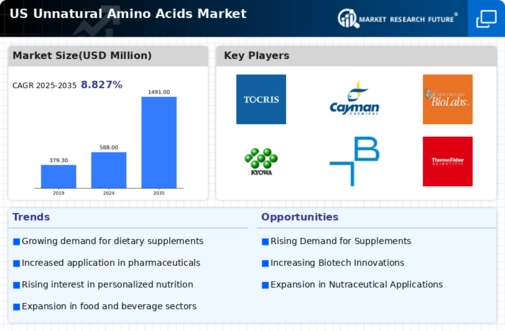Advancements in Biotechnology
Technological advancements in biotechnology are significantly influencing the unnatural amino-acids market. Innovations in genetic engineering and synthetic biology have enabled the production of unnatural amino acids with enhanced properties and functionalities. These advancements allow for more efficient and cost-effective production processes, which can potentially lower prices and increase accessibility. The biotechnology sector is projected to grow at a CAGR of around 7% through 2027, suggesting a favorable environment for the unnatural amino-acids market. As companies leverage these technologies, the market is expected to expand, driven by the introduction of novel products and applications.
Rising Demand in Food Industry
The food industry is increasingly recognizing the potential of unnatural amino acids, contributing to the growth of the unnatural amino-acids market. These compounds are utilized as flavor enhancers, preservatives, and nutritional supplements in various food products. The unnatural amino-acids market is projected to reach $50 billion by 2026, with a significant share attributed to amino acids. As consumers demand healthier and more functional food options, manufacturers are likely to incorporate unnatural amino acids to meet these needs. This trend indicates a growing acceptance and application of these compounds in food production, further driving market growth.
Increasing Applications in Pharmaceuticals
The unnatural amino-acids market is experiencing growth due to their increasing applications in the pharmaceutical sector. These amino acids are utilized in drug formulation, particularly in the development of novel therapeutics. For instance, they are essential in synthesizing peptide-based drugs, which have shown efficacy in treating various diseases. The market for peptide therapeutics is projected to reach approximately $50 billion by 2026, indicating a robust demand for unnatural amino acids. Furthermore, the rise in chronic diseases necessitates innovative drug solutions, further driving the need for these compounds. As pharmaceutical companies continue to invest in research and development, the unnatural amino-acids market is likely to benefit significantly from this trend.
Emerging Research in Therapeutic Applications
Ongoing research into the therapeutic applications of unnatural amino acids is a key driver for the market. Studies are exploring their potential in treating conditions such as cancer, metabolic disorders, and neurodegenerative diseases. The increasing focus on personalized medicine and targeted therapies is likely to enhance the demand for these amino acids, as they can be tailored to specific therapeutic needs. The research and development expenditure in the US healthcare sector is expected to exceed $200 billion by 2026, indicating a strong commitment to innovation. This investment is likely to foster advancements in the unnatural amino-acids market, as new applications and formulations are developed.
Growth in Nutraceuticals and Dietary Supplements
The rising health consciousness among consumers is propelling the growth of the unnatural amino-acids market, particularly in the nutraceuticals and dietary supplements sector. Unnatural amino acids are increasingly incorporated into supplements aimed at enhancing athletic performance, muscle recovery, and overall health. The dietary supplement market in the US is expected to surpass $50 billion by 2025, with a notable portion attributed to amino acid-based products. This trend is driven by the growing preference for natural and functional foods, as consumers seek products that offer health benefits. Consequently, the demand for unnatural amino acids is likely to rise as manufacturers innovate to meet consumer expectations.























Leave a Comment